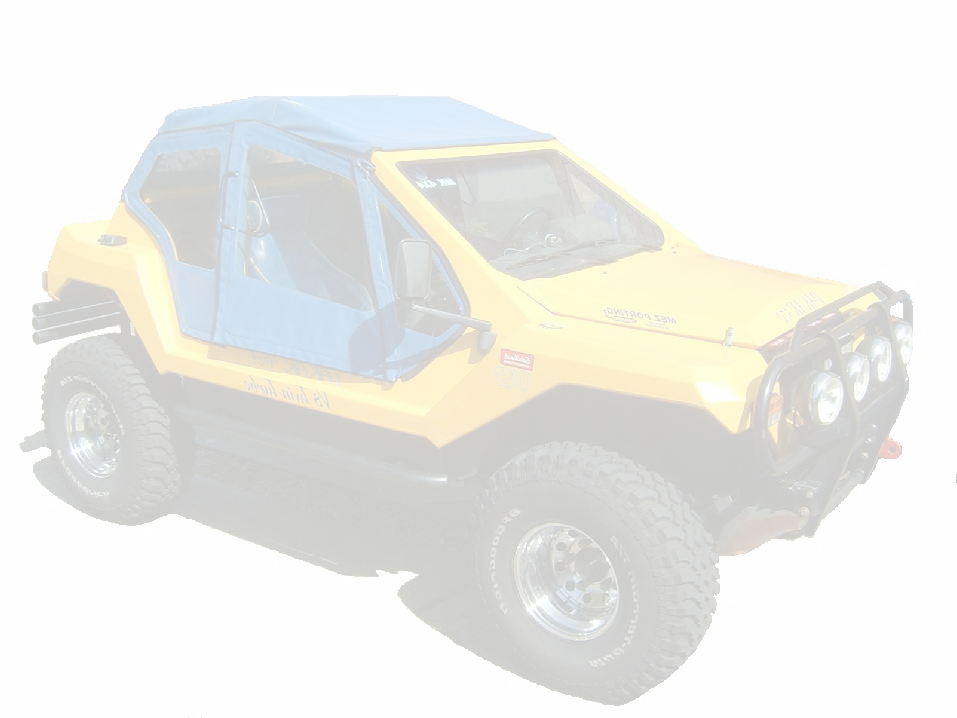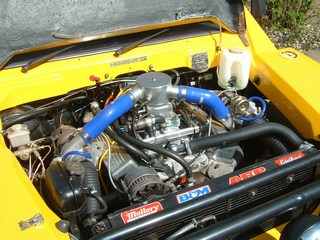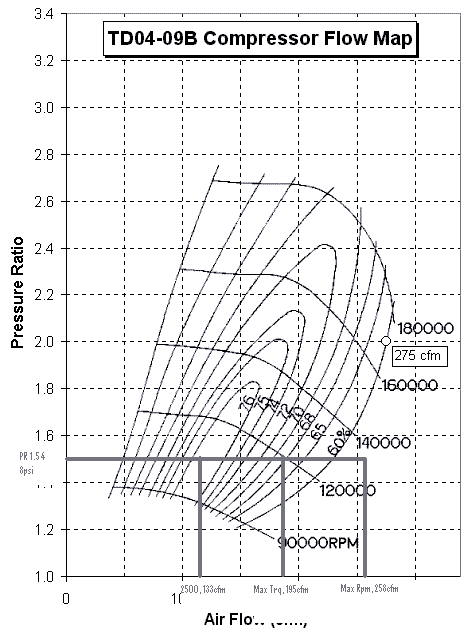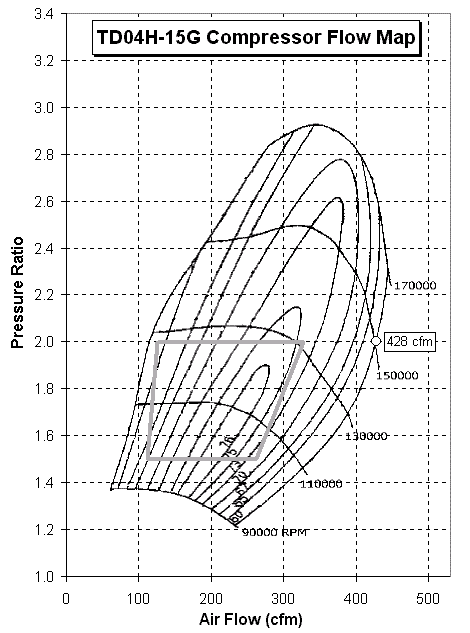
Twin turbocharged 350 Chevy project

The following 12 pages details the design, selection and fabrication of a twin turbo Chevy 350.
- Was it worth it? -
Yes, - Recommend it? -
Yes!
A quick summary of what I've learnt:
Gearbox -
Cooling -
Even on low boost -
Research
I've spent many months already looking at different options -
Now that I've got fuel and spark all controlled by MegaSquirt, I can now start thinking
about turbo or supercharging. I could just drop in a big block, but they are big
and heavy -
You have probably read this a million times, but I would also recommend reading Corky Bell's Maximum Boost book; Not just to understand about turbos, but also intercooling, plumbing, wastegates and lots of other general info along with some good photo's to show whats possible.
Supercharging?
Using a Wieand/Holley 142 Roots blower -
Problem was, I had never seen anyone else attempt it and I had never seen one of
these blowers in person -
It looks like there's enough room (JUST) to machine injector bungs into the manifold,
so I emailed holley and asked if there superchargers work OK on a dry charge -
I've also looked at centrifugal superchargers (Paxton, Vortech etc), these offer a much simpler installation, but with downside that they offer the worst of both worlds; they consume power all the time and you dont get full boost until max rpm.
Turbo charging?
This seems the most flexible and powerful -
I'm a little worried about the amount of heat that's going to be under the bonnet, Chevy's aren't exactly the coolest running engines on the planet, but i think I should be able to manage that effectively
Single or Twin turbo?
The decision for single or twin turbos comes down to one thing: What can I easily and cheaply get hold of, whatever i find first will be fitted. Essentially i need a pair of turbos that were originally fitted to at least a 2.5 litre engine.
V8's lend themselves to twin turbos due to packaging. Fitting a single turbo requires cross over pipe; in a 4x4 i cant go underneath due to the front axle (which already hits the sump), I could go over the top, but that's lots of unnecessarily hot exhaust pipe bellowing heat all over the engine bay.
Sourcing a pair of smaller turbo's in the UK seems an easier task than finding a big single. some tt pictures?
Boost pressure
Boost pressure is largely determined by your static engine compression and inlet charge temperature, a European NA engine will typically be running in the low 9's (Yes, I know i'm running a yank engine, but mines running 9.25:1 CR)
You will probably want to turn the boost pressure up once you get everything working, so my spreadsheet has entries for a range of boost pressures, which makes plotting the points on the compressor map much easier, you don’t want to select a turbo that's only good for 8psi and have to junk it all to run 12psi or more.
Turbo Sizing
I know that a pair of Garrett T3's from a factory 2.4 liter Ford Thunderbird Turbo Coupe, Which have a .60 A/R compressor and .63 A/R turbine will work, problem is that you don't see many(if any) of that spec turbo in the UK.
So far I haven't come across a diy scrapyard turbo conversion using turbo's easily sourced in the UK (Read:Ebay!). So I need to understand my flow requirements and plot that against potential candidates.
I'm not going to re-
Here's the calculations for my Chevy, using my Excel Spreadsheet that I developed from the formulas presented in the document above: (Also includes a handy Garrett Trim calculator)
These figures are for each turbo, i.e. the figures are halved, we have cfm,lbs and Kg/s for the different manufacturers. I'm not 100% sure the Kg/s figures are correct, but the Lbs/s figures closely match what you get on Turbofast's turbo calculator. Click Here to see the table in a new window.
Now that we understand how air is required for the entire rev range at a selection of boost pressures, we can now start studying the compressor maps. Draw a line across the graph at your desired Pressure Ratio (PR), and intersect that with your flow figures:
Turbo Selection
In order to plot a compressor map, the points from the table we are interested is the flow at Red Line (5500), the Flow at Max Trq (3500) and flow at a lowish rpm (2500) for my initial desired boost, i.e. 8psi, these correspond to 133 cfm, 194cfm and 258cfm at a pressure ratio(PR) of 1.54

There's several problems with this compressor; first at max rpm the compressor wont
produce enough flow. secondly at max torque you want your flow to be close to the
central 'island' which is the most efficient part of the map -
So select a bigger turbo and plot your points again, this time I have also plotted
the points for the other boost pressures -

The pink line, represents the flow figures at Max torque, we can see that they are
closer to the central island, also this compressor would be more efficient working
at around 10-
Using my table, I have adopted a slightly different, quicker method for plotting compressor maps for various boost pressures, you pick the four corners of the table representing the min rpm and min boost and max boost and max rpm that you are likely to ever want from the turbo (or your engine)
So from above I chose (pr 1.54,2000)=105cfm, (pr1.54,5500)=258cfm, (pr 2.09,2000)=127,(pr2.09,5500)=311, plot those four points on the map and join the dots up:

We can now see that all my desired flow figures are within the island of the compressor, if anything it's a bit on the big side and the 13g would be a better match. However, the turbine (Exhaust side) on the 13g would be far too small to flow 2.8L (5.7/2)worth of exhaust gas. Indeed, even the 15g may prove to be to small also.
Related Links
There's lots of stuff out there on the net, just be patient and keep searching.
Turbo calcs:
Steal316 site, shows how to calculate and select turbos
Finding Junkyard turbos:
Dunebuggy.com, picking turbos from junkyard.
PDF showing exactly what turbo was fitted to just about every car in the world -
Forums, fabrication:
Good diy turbo related forums -
Compressor Maps:
Garrett GT32
Ive obtained a nearly identical pair of Turbos. One is a Garrett GT3267s and the other is a Perkins badged version of the same thing, although with slightly different sizes.
Here's the info i have on them (so far):
Garrett:Cust PN:14411 9X800, AS PN:706705-
Perkins: Model 2674a343,Compressor AR ???, Turbine AR .75, Compressor wheel Minor
49.25mm (1.92')-



